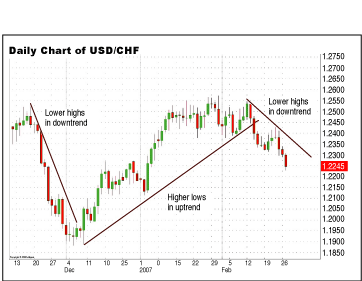Access to foreign exchange trading has opened up exciting trading options for the retail trader. You can now trade alongside corporations and institutions in a highly liquid market that is global, traded around the clock, and highly leveraged. Before jumping into this market, however, we must understand the factors that affect the forex market. With that in mind, STOCKS& COMMODITIES has introduced Forex Focus to better prepare the retail trader to participate in the currency market.
Making Sense Of Currency Movements
by Grace Cheng
With currency movements so randomized, how could you possibly know when to enter and exit trades?
One of the most frequently asked questions among forex traders is certainly this: What on earth is [any currency pair] doing? This question tends to come up especially when you have open positions in the forex market. The nonstop fluctuations of a currency pair's exchange rate may seem totally random. Some traders will question if it is possible to even trade accurately in such a random market.
Making sense of currency price movements is not transgenic science. Once you know the core behavior of currencies, you will find it easier to understand their movements and exploit them for profitable trading opportunities.
FUNDAMENTAL BEHAVIOR OF CURRENCY PRICES
Currency pairs either move in a trend or within a range. This concept is so simple and yet so revealing that I have to say it again. Currency pairs either move in a trend or within a range. Once you digest this fact, you will come to the realization that currency price behavior can be understood to a large extent and exploited to your advantage.
Some people prefer to trade trends while others may be more comfortable trading ranges. But what is a trend?
In technical analysis, a trend can be categorized into two types: an uptrend or a downtrend. An uptrend generally consists of higher lows and higher highs over a period of time (when prices tend to go higher), whereas a downtrend is generally made up of lower highs and lower lows over a period of time (when prices tend to go lower).
Of course, such a rigid textbook definition is not always manifested in real market conditions. In an uptrend, the most important thing to look out for is the series of higher lows, and in a downtrend, you should be able to see a series of lower highs (see Figure 1).

FIGURE 1: TRENDING ACTION ON DAILY CHART OF USD/CHF. In an uptrend, the most important thing to look out for is the series of higher lows, and in a downtrend, you should be able to see a series of lower highs.
If a currency pair is not moving in a trend, then it must be stuck within a trading range. A range consists of price movements within two boundaries, with one being a resistance level and the other being a support level (see Figure 2). Basically, a currency pair moving in a range tends to swing from an upper end to a lower end and vice versa. A range can also be called a sideways trend.
Originally published in the April 2008 issue of Technical Analysis
of STOCKS & COMMODITIES magazine. All rights reserved. © Copyright
2008, Technical Analysis, Inc.
Return to April 2008 Contents